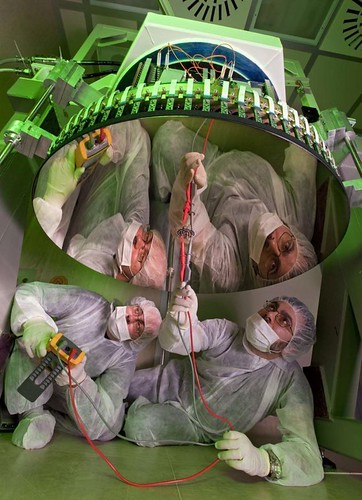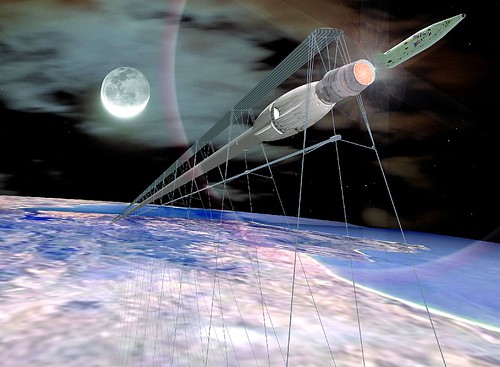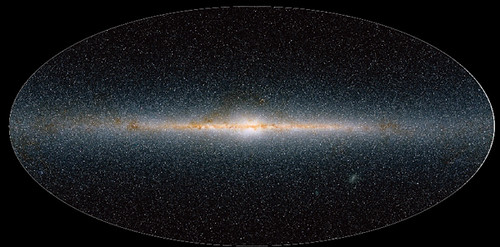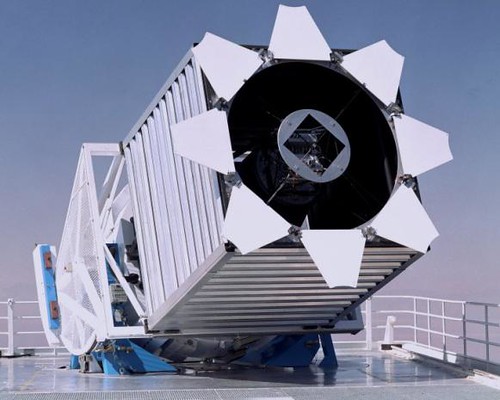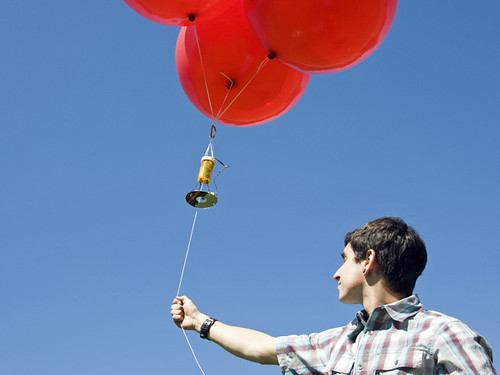Awesome idea: using a 20 km (12.7 mile) evacuated tunnel to launch payloads into space using magnetic-levitation technology. Where do you start with such a grand scheme? Try the inventor of mag-lev, James Powell.
Question 1: How did the Startram concept originate?
Gordon Danby and I invented the superconducting Maglev transportation system in 1966 when we were working for Brookhaven National Laboratory. Based on our 1966 inventions, Japan has built and is operating a 300 mph Maglev passenger transport system. Subsequently, in the 1990s, I started working on how to use Maglev to launch large volumes of payloads into orbit at very low cost. I realized that traveling in evacuated tunnels with no air drag, maglev vehicles could reach orbital speeds with extremely low energy inputs. At 8 kilometers per second, it takes only 10 kilowatt hours of electrical energy per kilogram of payload. Using magnetic levitation and propulsion, spacecraft operating in a maglev can propel multi-ton payloads to orbit, albeit at high g forces. I have collaborated with a number of people on this project and we have all come to the conclusion that this concept is feasible.
Question 2: You have developed GEN 1, and GEN 2 concepts. What distinguishes each of these generations?
GEN 1 Startram is designed to accelerate unmanned cargo craft to orbital speed of 8 kilometers per second in an evacuated underground tunnel. The cargo craft leaves the tunnels exit into the atmosphere at an altitude of about 16,000 feet. It then coasts up through the atmosphere into space. Upon reaching the desired orbital altitude, a small on-board rocket is fired to establish the payload’s final orbit. With the aid of an onboard rocket, this GEN 1 system should be able to take cargo into LEO. Due to the 30g loads as it accelerates in the evacuated tunnel GEN 1 would not be able to take humans or live animals into orbit. The GEN 2 system would be considerably more difficult to develop and implement, and would require a magnetically levitated tube leading to an altitude of 60,000 feet, where the atmospheric density is very low. GEN 2, however, would have the capacity to take humans directly to orbit.
Question 3: You have also developed a GEN 1.5 concept.
Yes, the GEN 1.5 would effectively be a hybrid between GEN 1 and GEN 2. GEN 1.5 would use rockets after it entered the atmosphere to overcome atmospheric drag forces. instead of using the GEN 2 magnetically levitated evacuated launch tube that would ascend to an altitude of 60,000 feet, where the atmospheric density is very low. It would need a longer tunnel and an optimized hybrid rocket, but it could still be built within twenty years. It could bring about 100 passengers to orbit on each launch. It could be used for tourism, and would be considerably easier to implement than GEN 2.
Question 4 : You have claimed that a GEN 1 system could be developed for $20 billion. Given the tendency of large-scale projects to go overbudget, is this cost estimate realistic?
The cost would probably be more than $20 billion. I could see this project costing $40 billion, due to red tape and developmental difficulties. But even at $40 billion, the project would be a bargain. We have already sunk $150 billion into the international space station and have little to show for it.
Question 5: You also claim that a GEN 1 system could deposit large payloads into orbit for only $50 per kilogram, or about 1% of current launch costs. How confident are you of those figures?
The costs would depend greatly on how much payload you put into orbit. The system is completely reusable, and the electricity needed isn’t very expensive, only about 1 dollar per kilogram of payload. The $50 per kilogram figure is based on putting 100,000 tons per year into orbit. The current launch rate is about 200 tons per year, so this assumes that a major push into space occurs.
Question 6: What activity could justify putting 100,000 tons into orbit?
We see space-based solar power satellites as being a main driver of startram. There have been extensive studies on solar power satellites, and the biggest hurdle is the cost of putting so much material into orbit. Startram effectively solves that problem. And if we can have enough solar power satellites beaming clean, low cost electric power closer to earth, that would greatly ameliorate the world’s long term energy situation.
Question 7: How high would the evacuated tunnels need to be? Could they be made from standard materials?
The higher the better, but we would like to get to an altitude of 4 kilometers or higher. There are places in Alaska, China, and Peru that could provide that altitude. They would be drilled using conventional boring machines and lined with concrete. The construction methods would be similar to the building of the chunnel between Britain and France, only simpler, and require a much smaller excavation volume.
Question 8: Wouldn’t maintaining an evacuated tunnel present difficulties?
Most of the time the tunnel would be mechanically sealed with a shutter, and would only open for the few seconds when the cargo craft is accelerating in the tunnel. The tricky part would be the transition from a near vacuum to the atmosphere. We propose to use a magneto-hydrodynamic (MHD) current to pump the air away. The combination of an MHD window and a steam ejection system would effectively solve the problem. The small amount of air that managed to get through the MHD would be frozen by cryopanels and then pumped out after the cargo craft had left the tunnel, and it had been reseated by the mechanical shutter.
Question 9: How would you power this system?
The best way would be through superconducting magnetic energy storage. Between launches, superconducting loops store the energy required for the launch in a sequence of superconductivity loops located along the acceleration tunnel. As the magnetically levitated cargo craft approaches a given superconducting energy storage loop, a pulsed heating coil inside the superconductor into its normal high resistance state. The stored magnetic energy created by the superconductor current then inductively transfers into a closely coupled copper loop (more than 99% of the stored energy is transferred). The copper loop then powers the aluminum propulsion windings in the acceleration tunnel, magnetically accelerating the cargo craft to higher speed . This concept has not been demonstrated but I don’t anticipate that being a major problem.
Question 10: What is the most common criticism that you receive from this concept?
The concept is sufficiently radical that many people have a hard time grasping it. The aerospace industry has been fixated on rockets for the past fifty years, and costs have only come down marginally. Failure rates are still high. I haven’t received any trenchant criticisms regarding any specific detail of the concept. There are no potential “showstoppers” to this idea, it is simply a matter of getting enough funding.
Question 11: Assuming adequate funding, how long would it take to get a system up and running?
With an aggressive program, it could be done within a decade. With a more pedestrian effort, it would probably take 20 years. But the technical issues associated with Startram are much less than the comparable issues associated with the Apollo program, and Apollo took less than a decade to meet its objectives.
Question 12: Have you been actively seeking funding for Startram?
Not actively. I have been more focused on getting funding for our new 2nd generation maglev system, which is much lower in cost than the present 1st generation Japanese Maglev system that was based on our original 1966 inventions. The new 2nd generation Maglev system can transport fully loaded highway trucks, personal autos, and freight containers at lower cost than by highway. The much higher revenue for the 2nd generation Maglev system will enable private investors to build maglev routes without needing Government subsidies. So far, given the costs of developing Startram, neither the Government nor venture capitalists are interested. But GEN 1 could be privately financed if sufficiently wealthy individuals or corporations realized that this system could bring in revenues of hundreds of billions of dollars per year.
Question 13: Do you see the development of Startram as inevitable?
I do. If humanity is going to have a large-scale presence in space, then Startram will be need to be developed. Conventional rockets can’t get much better, and are far too costly, unreliable, and dangerous. The space elevator would require a breakthrough in materials, and collisions with space debris would be a serious problem. Once the GEN 1 and GEN 1.5 systems are developed, the entire solar system will rapidly become within humanity’s reach.
This is proven technology and should be pursued by both NASA and the commercial space industry.




